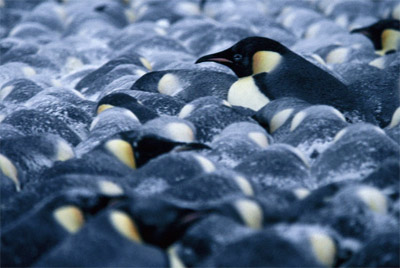While many bird species migrate to avoid to the chill of winter in temperate climates, some species, like the Emperor Penguin live year-round in frigid Antarctica, where temperatures can dip below -76°F and winds roar at 100 mph.
Emperor Penguins maintain their body temperature through a number of adaptations. While cozying up en masse, Emperor Penguins also rely on their specialized circulatory system, a thick layer of blubber, and densely packed feathers to stay warm.
 |
| Emperor Penguins huddle to stay warm. Photo from Warner Bros at http://www.coolantarctica.com/Antarctica%20fact%20file/science/cold_penguins.htm |
Birds in the Piedmont of North Carolina, and the upper Midwest, stay warm using similar adaptations. Some species will huddle together, with the birds at the end regularly switching places with the birds in the toasty middle. Ducks and gulls, for example, have specialized circulatory systems in their feet allowing for counter-current exchange, where warm blood leaving the body heats up the cold blood coming back into the body from feet sitting in icy water. Downy feathers also provide insulation against severe cold.
To return to our reader's question -- is there a temperature limit past which birds won't survive? -- my reply is that there must be, but of all the vertebrate taxa in the world, birds have managed to endure cold the most successfully.
No comments:
Post a Comment